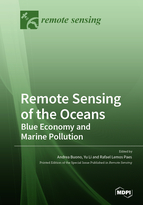Remote Sensing of the Oceans: Blue Economy and Marine Pollution
A special issue of Remote Sensing (ISSN 2072-4292).
Deadline for manuscript submissions: closed (31 December 2020) | Viewed by 39716
Special Issue Editors
Interests: electromagnetic modeling; SAR; polarimetry; ocean; coastal areas
Special Issues, Collections and Topics in MDPI journals
Interests: SAR; polarimetry; image processing; targets; machine learning
Interests: SAR; polarimetry; electromagnetic; image processing; machine learning
Special Issues, Collections and Topics in MDPI journals
Special Issue Information
Dear Colleagues,
The use of remote sensing tools to monitor the oceans is an enabling application in the fields of environment preservation and the blue economy. In fact, marine pollution due to anthropogenic activities, such as oil spills, plastic litter, and other debris, represents a dramatic threat to the marine ecosystem. In addition, there is a growing urgent need to exploit and explore new “green” sources and renewable energy, as well as a need to monitor all the critical infrastructures related to the blue economy. In this framework, a huge amount of multi-platform and multi-sensor remote sensing data is available across the scientific community that calls for the development of new methods and algorithms, as well as better assessment of state-of-art approaches. Hence, even though remote sensing tools for ocean monitoring are a well-established reality, we are still seeking for innovative methods and more accurate models.
The main goal of this Special Issue is to provide a reference framework for state-of-art remote sensing methods to observe marine pollution and to support the blue economy, as well as to promote and boost the most advanced methods and techniques in related fields. The topics of this Special Issue include, but are not limited to, the following subjects:
- Target monitoring using multi-platform and multi-sensor data
- New algorithms for marine resources exploration and exploitation
- New algorithms for marine ecosystem preservation
- Modeling and retrieval of geophysical ocean features
- Oil/gas fields
- Wind Farms
- Aquacultures
- Plastic litter
- Marine debris
- Oil spills
Dr. Andrea Buono
Dr. Rafael Lemos Paes
Dr. Yu Li
Guest Editors
Manuscript Submission Information
Manuscripts should be submitted online at www.mdpi.com by registering and logging in to this website. Once you are registered, click here to go to the submission form. Manuscripts can be submitted until the deadline. All submissions that pass pre-check are peer-reviewed. Accepted papers will be published continuously in the journal (as soon as accepted) and will be listed together on the special issue website. Research articles, review articles as well as short communications are invited. For planned papers, a title and short abstract (about 100 words) can be sent to the Editorial Office for announcement on this website.
Submitted manuscripts should not have been published previously, nor be under consideration for publication elsewhere (except conference proceedings papers). All manuscripts are thoroughly refereed through a single-blind peer-review process. A guide for authors and other relevant information for submission of manuscripts is available on the Instructions for Authors page. Remote Sensing is an international peer-reviewed open access semimonthly journal published by MDPI.
Please visit the Instructions for Authors page before submitting a manuscript. The Article Processing Charge (APC) for publication in this open access journal is 2700 CHF (Swiss Francs). Submitted papers should be well formatted and use good English. Authors may use MDPI's English editing service prior to publication or during author revisions.
Keywords
- ocean
- monitoring and modeling
- pollution
- resource exploration
- renewable energy
- critical infrastructures








